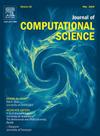Deep dive into generative models through feature interpoint distances
IF 3.1
3区 计算机科学
Q2 COMPUTER SCIENCE, INTERDISCIPLINARY APPLICATIONS
引用次数: 0
Abstract
This paper introduces the Interpoint Inception Distance (IID) as a new approach for evaluating deep generative models. It is based on reducing the measurement of discrepancy between multidimensional feature distributions to one-dimensional interpoint comparisons. Our method provides a general tool for deriving a wide range of evaluation measures. The Cramér Interpoint Inception Distance (CIID) is notable for its theoretical properties, including a Gaussian-free structure of feature distribution and a strongly consistent estimator. Our experiments, conducted on both synthetic and large-scale real or generated data, suggest that CIID is a promising competitor to the Fréchet Inception Distance (FID), which is currently the primary metric for evaluating deep generative models. This article is an extended version of the ICCS 2024 conference paper (Jajeśniak et al., 2024) [1].
通过特征点间距离深入研究生成模型
本文介绍了一种评价深度生成模型的新方法——点间初始距离(IID)。它基于将多维特征分布之间的差异度量减少到一维点间比较。我们的方法提供了一种通用的工具,可以推导出广泛的评价方法。cram点间起始距离(CIID)以其理论性质而闻名,包括特征分布的无高斯结构和强一致估计量。我们在合成和大规模真实或生成的数据上进行的实验表明,CIID是fr起始距离(FID)的一个有希望的竞争对手,FID是目前评估深度生成模型的主要指标。本文是ICCS 2024会议论文(Jajeśniak et al., 2024)[1]的扩展版。
本文章由计算机程序翻译,如有差异,请以英文原文为准。
求助全文
约1分钟内获得全文
求助全文
来源期刊

Journal of Computational Science
COMPUTER SCIENCE, INTERDISCIPLINARY APPLICATIONS-COMPUTER SCIENCE, THEORY & METHODS
CiteScore
5.50
自引率
3.00%
发文量
227
审稿时长
41 days
期刊介绍:
Computational Science is a rapidly growing multi- and interdisciplinary field that uses advanced computing and data analysis to understand and solve complex problems. It has reached a level of predictive capability that now firmly complements the traditional pillars of experimentation and theory.
The recent advances in experimental techniques such as detectors, on-line sensor networks and high-resolution imaging techniques, have opened up new windows into physical and biological processes at many levels of detail. The resulting data explosion allows for detailed data driven modeling and simulation.
This new discipline in science combines computational thinking, modern computational methods, devices and collateral technologies to address problems far beyond the scope of traditional numerical methods.
Computational science typically unifies three distinct elements:
• Modeling, Algorithms and Simulations (e.g. numerical and non-numerical, discrete and continuous);
• Software developed to solve science (e.g., biological, physical, and social), engineering, medicine, and humanities problems;
• Computer and information science that develops and optimizes the advanced system hardware, software, networking, and data management components (e.g. problem solving environments).
 求助内容:
求助内容: 应助结果提醒方式:
应助结果提醒方式:


